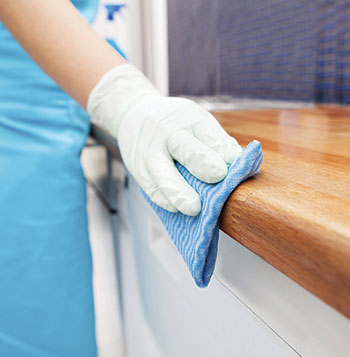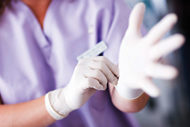Infection prevention leaders analyze best practices and role of environmental services teams in improving patient safety
 |
|
Engaged environmental services staff are key to infection prevention. Photo by Andreypopov/Thinkstock |
Despite some progress in the prevention of health care-associated infections (HAIs), the issue remains a priority that requires continuous vigilance and best practices exercised by all health care staff, especially those on the front lines.
Top infection control experts stressed those points and more during a recent media briefing to discuss the "Compendium of Strategies to Prevent Healthcare-Associated Infections in Acute Care Hospitals: 2014 Updates." The compendium updates articles published in 2008.
Erik Dubberke, M.D., MSPH, professor of medicine, Washington University School of Medicine, and a lead author of "Strategies to Prevent Clostridium difficile Infections in Acute Care Hospitals: 2014 Update" emphasized the need for a multidisciplinary response in fighting the bacteria.
"Health care is a team sport and this is especially true in the prevention of Clostridium difficile," Dubberke says. "It's essential to have the environmental services (ES) or housekeeping personnel involved as part of this multidisciplinary team."
Dubberke says there are a variety of methods that have been developed to examine the adequacy of cleaning such as the use of checklists and fluorescent markers and adenosine triphosphate bioluminescence assays. He says the most effective method is to keep ES staff engaged in the infection prevention process.
"Regardless of the method used, the most successful interventions have been those in which ES is in charge of the process of designing how they're going to clean the rooms and monitor the cleaning as well as being accountable for the results," he says.
The article "Strategies to Prevent Methicillin-Resistant Staphylococcus aureus [MRSA] Transmission and Infection in Acute Care Hospitals: 2014 Update" stressed the importance of compliance with the Centers for Disease Control and Prevention (CDC) or World Health Organization hand-hygiene recommendations to prevent the spread of MRSA.
Studies demonstrate that health care staff interacting with MRSA-colonized or infected patients often become contaminated with the organism, and surfaces and objects in the patient's environment quickly can become contaminated, too, the article states.
The development of detailed protocols for daily and terminal cleaning and disinfection of patient rooms is vital, the authors note. The study also emphasized the cleaning and disinfection of
high-touch surfaces such as bed rails, carts, bedside commodes, doorknobs and faucet handles.
David Calfee, M.D., MS, chief hospital epidemiologist, New York-Presbyterian/Weill Cornell Medical Center, New York City, served as a lead author of the update.
Asked about the challenges involved in improving hand-hygiene compliance rates, Katherine Ellingson, epidemiologist, Oregon Health Authority, says that the chief barriers are inadequate access to hand-hygiene products, lack of time and poor role modeling.
Hospitals with the most success take a holistic approach that emphasizes convenient location of hand-washing products, measuring behavior, feedback on performance and administrative support, Ellingson says.
Despite strides in infection prevention over the past decade, opportunities exist for further progress, says Deborah Yokoe, M.D., MPH, hospital epidemiologist and medical director, Infection Control Department, Brigham and Women's Hospital and Dana-Farber Cancer Institute, Boston.
The need for further gains is evident by CDC estimates that on any given day, one in 25 hospitalized patients will get an HAI, which translates to about 720,000 incidents per year, Yokoe says. The compendium serves as guidance for hospitals as they develop and prioritize HAI prevention strategies, she says.
Yokoe served as co-lead of the compendium update project with Lisa Maragakis, director of hospital epidemiology and infection control at Johns Hopkins Hospital and faculty member of Johns Hopkins University School of Medicine.
The compendium is a collaborative effort led by the Society for Healthcare Epidemiology of America, Infectious Diseases Society of America, American Hospital Association, Association for Professionals in Infection Control and Epidemiology, and the Joint Commission.





